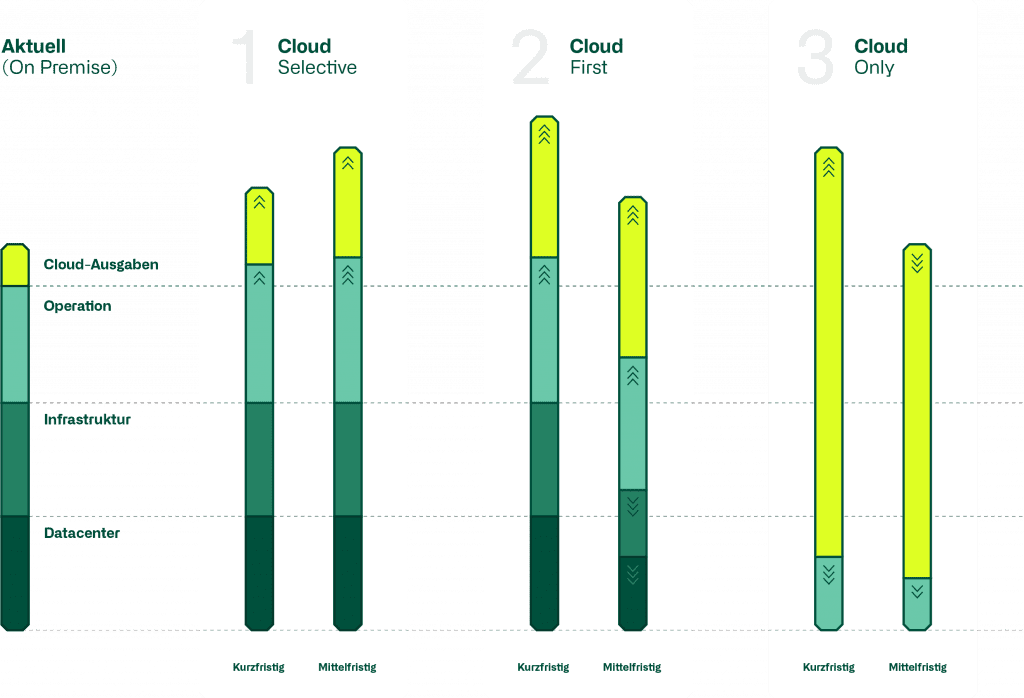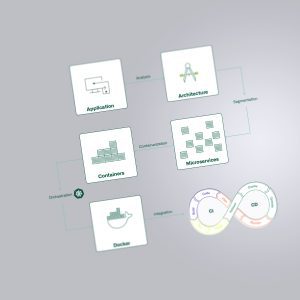Blog
Cost implications of cloud strategies
Developing the right cloud strategy is essential for a company. Depending on the strategy, different cost developments can be expected in the short or medium term.
With this blog, we create transparency on how costs can develop based on the different strategies.
Cloud as a business enabler
By implementing a suitable cloud strategy, a company's flexibility, cost efficiency, scalability and innovative strength can be significantly increased. As a business enabler, the cloud makes it easier to keep up with a rapidly changing market environment. Different cost models make it possible to optimise the costs incurred. Thanks to flexible adjustments in real time, the scalability of services can also be guaranteed during peak times. Last but not least, the cloud, as the heart of the digital transformation, enables the innovative power that forms the premise for successful digitalisation through its continuous and rapid further development.
Cloud strategies
Strategies such as cloud selective, cloud first and cloud only offer different approaches and procedures for the path to the cloud. Cloud selective provides for the shift of individual, non-critical services to the cloud. This approach primarily serves to gain experience and is invoiced according to need on the basis of "pay-as-you-go". The on-premise infrastructure is supplemented by the cloud services, but not dismantled for the time being. Consequently, the operating resources will increase accordingly by the cloud portion.
Cloud first strategically places the focus on the cloud. If technically and economically feasible, new and adapted services are operated in the cloud. Due to this gradual increase in the proportion of cloud services, their operation is also being intensified.
Cloud only aims to replace all on-premise systems with the cloud in a timely manner. The Lift & Shift approach enables a rapid shift to the cloud through the use of IaaS (Infrastructure as a Service), without having to make fundamental adjustments to the architecture.
Cost implications of cloud strategies
The implementation of the cloud strategies mentioned causes different cost developments in different areas. The costs vary depending on the phase or time horizon of the implementation. The following figure illustrates the differentiated cost generation and distribution per strategy on a short- and medium-term time horizon using an example list.

Within the framework of the cloud selective strategy, the cloud share is constantly increasing due to the selective shifting of individual applications. The cloud costs increase, whereby the on-premise infrastructure cannot be reduced or can only be reduced minimally. With the increasing number of productive systems in the cloud and their operation, corresponding resources must be allocated. The resulting parallel operation of cloud and on-premise results in a continuous increase in costs.
During the implementation of the cloud-first strategy, costs rise sharply in the short term due to the increasing cloud resources and their operation. However, on-premise resources cannot be reduced at the same rate. Staying too long in this phase can therefore result in a massive increase in overall costs. The introduction of various measures can counteract the rise in costs. On the one hand, the decreasing need for on-premise infrastructure must be taken into account in lifecycle projects as they arise. The reduction of hardware used offers the possibility of additional optimisation potential in the data centre (rack space). On the other hand, the further development of staff into new job profiles enables them to be used for more value-adding activities (in addition to operating the existing on-premise infrastructure).
The costs of implementing the cloud-only strategy will probably be higher than the on-premise costs in the short term, provided the migration is carried out without adjustments to the system architecture (lift & shift approach). In the medium term, optimisations such as refactoring and replacement, continuous rightsizing of the cloud resources and the application of suitable billing models (e.g. "reservations") will enable costs to be saved. At the same time, existing operating costs should be reduced or their resources used for value-adding activities.
Recommendation
The use of the cloud offers significant advantages in terms of innovation, new technologies, more efficient processes, higher product and service quality and scalability. Their weighting and evaluation can vary depending on the business model, overall strategy and size of a company.
Be it cloud selective, first or only: controlling and optimising costs is a continuous process that needs to be paid attention to. The management of services and the resulting costs must be continuously checked and optimised. For example, this is made possible by increased cost transparency through tagging, adjustments to cost models, rightsising and scale up/down.
In order to be able to exploit the full potential of the cloud, the opportunities and advantages that the cloud can offer your company must be constantly aligned and optimised. Moreover, the opportunities that arise from the continuous and rapid development of the cloud far exceed the potential of an on-premise landscape.
Accordingly, cost reductions should not be the primary incentive for the move to the cloud. In the short term, an increase in costs is always to be expected; in the medium term, only a cloud-only strategy can lead to a cost level comparable to today. In the pragmatic implementation of a cloud first strategy, the reduction of on-premise costs must take place as soon as possible so that the total costs do not get out of control.




